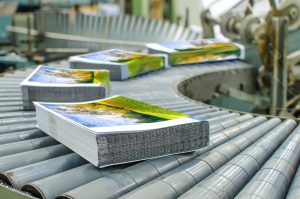Print finishing adds the “wow” to your work. With a simple process, it takes print projects to the next level. You can achieve almost any look you can think of. Where there’s a desired end, there’s a finish for that. This guide will give you an in-depth look at the volume of finishes and when to use them.
What is Print Finishing?
The term refers to a process that’s achieved after the ink has dried on your print project. It can elevate the look of the piece or offer needed water or tear-proof protection. It’s the cherry on your sundae that “finishes” the print job.
Print Finishing Techniques
There are a variety of finishing methods, and you even combine several for enhanced effects. Here are the most popular finishes:
Cutting and Creasing
In this mechanical process, a die cutter machine will cut the printed piece to its desired shape. The die itself will support the substrate (material that was printed on), and a punch made with cutting blades is lowered down to cut it. Dies can be designed in virtually any shape, and they’re perfect for brochures, invitations, packaging, and more. For the folding process, printers use the same technique, but with a blunt blade to crease the paper so it can be folded easily. This method works well for folders, packaging, and invitations.
Lamination
One of the most common finishes, lamination can be done with a glossy, silk, or matte look—and is a smart way to protect the printed surface from bending or tears while also providing a level of water resistance. It’s commonly applied for soft covered books, posters, and business cards. You can go glossy to keep the printed materials sharp and use matte for a more elegant feel. Silk is a sheen that’s in between. There are great green options for lamination that are biodegradable, sustainable, and recyclable. There are also textured laminations to enhance the touch with a luxurious feel.
Varnishing
Like a lamination, varnishes can be applied sealing in a glossy, silk, or matte finish. And like with wood, they provide a certain degree of protection against the elements along with an attractive finish. You can play with varnish intensities to create special effects like leather or decorative patterns, and the glitter varnish can coat your print with a dazzling sparkle. Varnishes are used frequently for magazine covers, magazine interiors, brochures, stationery, promotions, or decorative designs.
Related: Embellishments: How to Dress Up Your Print Materials
In addition to the three sheens, there are other varnishing techniques to try. UV varnishing is popular. By using an ultraviolet light to dry the coating and create a transparent finish, this effect heightens colors and makes images more vivid. It appears as a smooth, glossy coat and can be applied as an all over UV varnish to cover the entire piece, usually with a gloss UV varnish—or as a spot UV varnish to highlight a word, image, or another focal point. You can also try a textured spot UV varnish. This special technique adds one more dimension, giving a textured look to the spot UV varnish. A car manufacturer might print a brochure with a textured spot UV varnish that shows the shine of the car to make it come alive and look as true to life as possible.
Related: What is UV Gel Printing?
Ink Colors
Even after the ink has dried, you can still add more ink! Pearlescent and iridescent inks cover the spectrum of the rainbow, and pick up the light when viewed from different angles. This unexpected look is striking. Use this for high end brochures or pieces that highlight high end products.
Glow-In-The-Dark Effects
Can you picture a Halloween card that glows in the dark? You get this look with a phosphorescent or fluorescence method that prints light sensitive materials that absorb energy—and then illuminate themselves. This finishing technique is great for invitations, brochures, and anything that you want to stand out in the dark.
Soft Touch Coatings
Paper that’s butter to the touch has received a soft touch coating that makes it incredibly touchable and tactile. Invitations and packaging are great places to apply this finish.
Related: Coated vs. Uncoated Paper: When to Use (Or Not Use) Each
Foil Stamping
With a metallic material to accentuate certain words or an image you can give your brand some serious cache. The foil stamping process uses heat and pressure to apply metallic foil to the substrate. There are a number of metallic colors available, including gold, silver, copper, pigmented, holographic, and even security. Many times, this method is paired with embossing (coming soon) for a more pronounced look with ink that appears even shinier and glossier. Books, cards, invitations, packaging, magazines, and more all benefit from this premium treatment.
Related: Unique Business Cards Convert
Embossing
When you raise the font on a book cover or invite by stamping it to make it 3D, you’re also raising the bar. Not only do embossed elements stand out texturally, but they look very high end. As stated earlier, you can combine this process with foil stamping (or spot UV lamination) for extra style points. Embossing works well on business cards, brochure covers, invitations, and more.
Debossing
The opposite of embossing, this process creates a concave area where the substrate is pushed in. Also called letterpress printing, it’s one of the oldest printing methods around. Debossing is used for labels, logos, brochure covers, and more.
Related: Possibilities of Print: Elevated Holiday Cards
Thermography
Like embossing, thermography elevates your look with raised text or images, achieved through a special ink. With various thermographic powders in the ink, you can produce different looks. Create a metallic sheen with metallic powder, a glittery one with glitter powder, or a brighter one with fluorescent powder. Thermography works well for invitations, brochure covers, packaging, and more.
Edge Painting
Leave no page uncovered! With edge painting, you’re even giving attention to the edges of the pages. With a sprayer or brayer, you can achieve a finished look with any color, including foils and metallic. It’s common for books and can be used on invitations, journals, and even business cards for an unexpected touch.
There’s a lot to consider and a lot that can be done with these incredible print finishing techniques. When you’re designing your projects, make sure finishes are in your plans and in your budgets. As print fanatics, we’re finish fanatics too. We use state-of-the-art equipment to achieve these finishes for a look that will wow every time. Finish strong with us!




